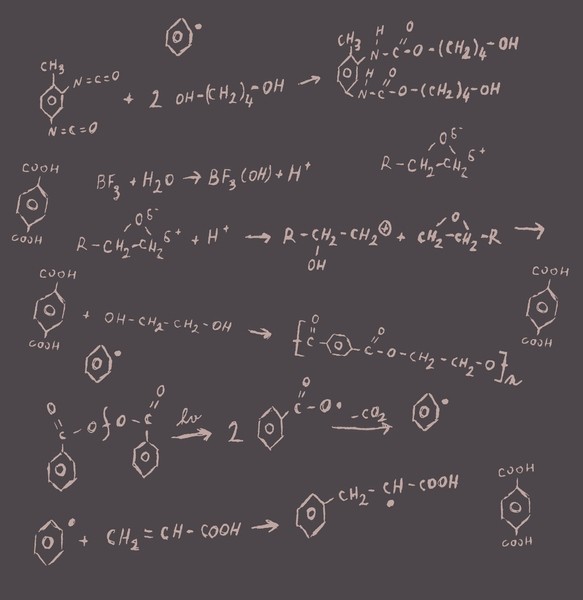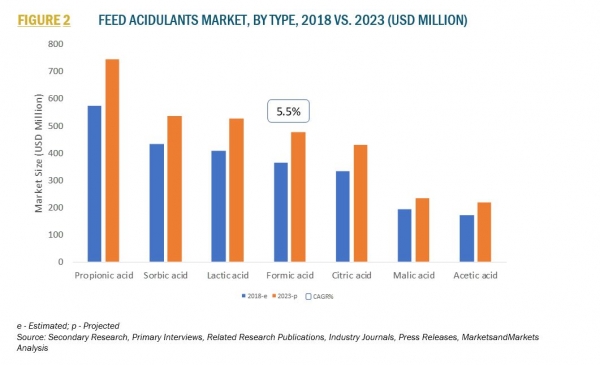Demand for feed acidulants such as formic acid is increasing

The major types of feed acidulants for livestock feed includes propionic acid, formic acid, citric acid, lactic acid, sorbic acid, malic acid, and acetic acid.
The formic acid segment is expected to be growing at the fastest rate during the forecast period, in terms of value, said Bhawna Sharma, research analyst, food, beverage, animal feed and agriculture.
“Formic acid, which has multiple functionalities, currently accounts for 13% of the overall, global feed acidulants market,” she told us.
The acid’s antibacterial components help with feed preservation, and this is the major reason why formic acid is prized in the feed sector, said Sharma.
Apart from being used for the preservation and acidification of feed mixes, that acid also acts as an ensiling agent. It is environmentally safe, as it decomposes after it has been used in that way, she said.
Formic acid is a colorless fuming liquid and remains soluble in water in almost all proportions. Those characteristics allow for optimal mixing in feed, thereby allowing consistent feed formulations, said Sharma. While formic acid remains highly efficient in improving apparent total tract digestibility (ATTD) of protein, it also aids in improving feed efficiency, said the analyst.
Formic acid, when used in tandem with propionic acid, further enhances in functionality, she continued. “Care has to be taken as regard to dosage levels, though, as too much can affect properties such as the palatability of the feed, and have a knock-on effect on feed intake and other parameters.”
Blended compounds
Blended compounds can address various issues in feed. They are preferred by livestock producers over standalone acidulant products for their synergistic action to improve animal health and performance, she said. They can help to provide a prophylactic effect, explained Sharma. “These compounds help to reduce the presence of harmful microorganisms in feed, in addition to promoting beneficial microbial growth in the gut.”
The market for feed acidulants is largely concentrated in Asia Pacific, followed by Europe in terms of value and volume, due to a shift away from antibiotics in animal production. Their usage in Asia Pacific is owing to the rapid economic growth in the region and the increasing consumption of meat and dairy products, especially in countries such as China, India, Japan, and Thailand. One trend that is creating more demand for feed acidulants in the UK, in particular, is the rise of the megafarm in that market, noted Sharma.
Price pressure
However, price pressure and supply constraints are expected for acidulants given the fact there are multiple industries reliant on them, she said. “Formic acid, for example, is being increasingly used in the oil and gas industries, in shale gas exploration but also in de-icing, in leather processing, where it ensures the efficient fixing of dyes and retanning agents”
Propionic acid is also used pharmaceuticals, crop protection agents, solvents, food and plastics.
BASF has been steadily increasing its formic acid and propionic acid prices in recent years, citing higher production costs, increasing demand and tightening supply.
Feed Acidulants market by type – forecast growth
“To gather the data [in figure 2], we looked at the compound feed production and what kind of feed additives are being consumed in different countries, in the different regions, and in what proportion, as well as the regulatory norms per markets that dictate the inclusion rates.
“We made an estimate on consumption of a given feed additive in a given livestock per country, and whether feed acidulants are acting as replacements for other additives. We looked at drivers and opportunities per market, at who the major players offering these products are, and how many new market entrants there have been in the past five to ten years, and how many would be expected to enter the market in the future. We also evaluated the production of various additives by manufacturers at different geographic points, and where they are being consumed, to determine growth rates per country. We summed all that up that to arrive at the regional estimation and then the global estimation.”
Major suppliers
The major suppliers in the global feed acidulants market are BASF, Yara International ASA, Kemin, Kemira OYJ and Biomin. Impextraco, Pancosma, Nutrex, Perstorp, Novus International, Jefo Nutrition Inc, Anpario, Corbion, ADDCON Group, and Peterlabs in Malaysia are others that have a significant share of the feed acidulants market.












